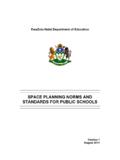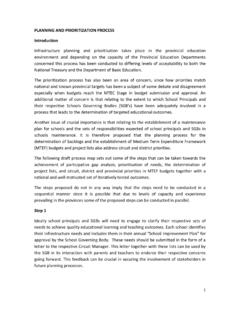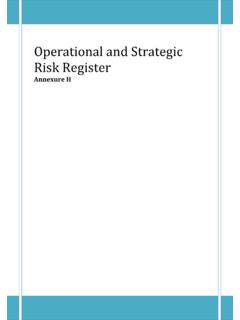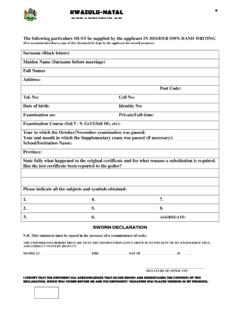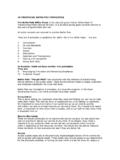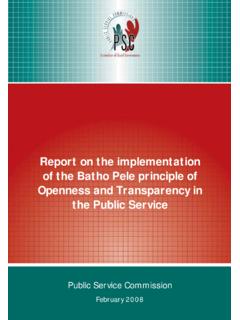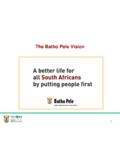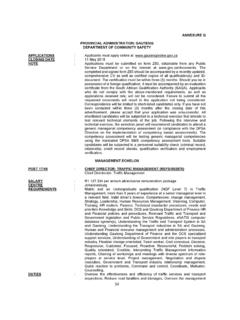Transcription of The context of service delivery and the machinery of ...
1 CONTENTS Chapter 1 The context of service delivery and the machinery of government Objectives 1 Vision and mission 5 Introduction 6 How to use this guide 7 What is Batho Pele 8 Batho Pele revitalization strategy 13 The balanced scorecard 15 context of service delivery 16 Linkages to Batho Pele from the regulatory framework 22 The values of Batho Pele 25 The principles of Batho Pele 26 The machinery of government 29 service delivery system 40 Key considerations 45 Useful references 45 Training opportunities 46 Chapter 2 Translating strategic goals to operational plans Introduction to translating strategic plans to operational plans 47 How to use this guide 48 What is an operational plan?
2 49 Translating strategic goals to operational plans as a learning opportunity 50 Guidelines to translating strategic goals to operational plans 50 The objectives of translating strategic goals to operational plans 51 Links to legislation 52 Links to Batho Pele 52 Key performance indicators 52 Outcomes 53 Challenges and responses 53 Step by step guide to translating strategic to operational plans 56 Key considerations 61 Useful references 61 Chapter 3 How to delegate Introduction to the guide on how to delegate 62 How to use this guide 64 What is delegation 64 Delegating as a learning opportunity 65 Guidelines on how to delegate 66 Objectives of delegation 69 Links to legislation 70 Links to Batho Pele 71 Key performance indicators 71 Outcomes 71 Challenges and responses 72 Step by step guide to delegating 75 Key considerations 79 Useful references 79 Training opportunities 79 Chapter 4 service
3 delivery charter Introduction to service delivery charter 80 How to use this guide 82 What is a service delivery charter? 83 Specimen of a service delivery charter 84 service delivery charter as a learning opportunity 85 Guidelines for developing a service delivery charter 85 The objective of developing a service delivery charter 86 Links to Batho Pele 86 Links to legislation 87 Code of conduct 89 Key performance indicators 89 Outcomes 89 Challenges and responses 90 Step by step guide on developing a service delivery charter 92 Some key considerations 95 Useful
4 References 96 Training opportunities 96 Chapter 5 How to develop service standards Introduction to setting service standards 97 How to use this guide 99 What are service standards? 99 service delivery charter 103 Pre-requisites for setting service standards 103 Setting service standards as a learning opportunity 104 Levels and types of standards 108 The balanced scorecard 110 Levels of standards 111 Objectives 112 Links to legislation 112 Links to Batho Pele 112 Key performance indicators 113 Outcomes 113
5 Challenges and responses 114 Approaches to developing service standards 115 Step by step guide to setting service standards 117 Key considerations 124 Useful references 125 Chapter 6 How to consult Introduction to how to consult 126 Why is consultation important in the public service ? 127 How to use this guide 127 What is consultation? 128 Consultation as a learning opportunity 128 Guidelines for consultation 130 The objectives of consultation 133 Links to Batho Pele 134 Links to legislation 134 Key performance indicators 134 Outcomes of consultation 135 Challenges and responses 135 Step by step guide 136 Key considerations 157 Useful references 158 Chapter 7 Wayfinding and signage Introduction to how to wayfinding and signage 159 How to use this guide 160 What is wayfinding?
6 162 The objectives of a wayfinding system 163 Links to legislation 164 Links to Batho Pele 164 Outcomes 165 Key performance indicators 165 Guidelines for an effective wayfinding system 167 Making your own signs 175 Language usage on signs 179 Sign categories 179 Catering for the functionally illiterate and disabled persons 183 Step by step guide to developing a wayfinding system 186 Key considerations 189 Useful reference 191 Chapter 8 Handling complaints Introduction to handling complaints 192 How to use this guide 192 What is a complaint?
7 193 Complaints handling as a learning opportunity 193 Guidelines for complaints handling 194 Objectives of setting a 195 Links to legislation 196 Links to Batho Pele 197 Key performance indicators 197 Outcomes 198 Challenges and responses 198 Step by step guide 201 Key considerations 208 Useful references 209 Chapter 9 Self-Assessment Introduction to self-assessment 210 How to use this guide 211 What is self-assessment? 211 Self-assessment as a learning opportunity 212 Guidelines for self-assessment 212 The objectives of self-assessment 213 Links to Batho Pele 213 Key performance indicators 214 Outcomes of self-assessment 214 Challenges and responses 214 Step by step guide 220 Key considerations 229 Chapter 10 Peer review Introduction to peer review 231 How to use this guide 231 What is peer review?
8 232 Peer review as a learning opportunity 232 Guidelines for peer review 233 The objectives of peer review 234 Different forms of peer review 234 Areas of application for peer review 235 Example of peer review 236 Example of institutional peer review 238 Links to Batho Pele 239 Links to legislation 240 Key performance indicators 241 Outcomes of peer review 242 Challenges and responses 242 Step by step guide to conducting peer review 245 Some key considerations 250 Useful references 250 CONTENTS OBJECTIVES 1 VISION AND MISSION 5 INTRODUCTION 6 HOW TO USE THIS GUIDE 7 WHAT IS BATHO PELE 8 BATHO PELE REVITALISATION STRATEGY 13 THE BALANCED SCORECARD 15 context OF service delivery 16 LINKAGES TO BATHO PELE FROM THE REGULATORY FRAMEWORK 22 THE VALUES OF BATHO PELE 25 THE PRINCIPLES OF BATHO PELE 26 THE machinery OF GOVERNMENT 29 service delivery SYSTEM 40 KEY CONSIDERATIONS 45 USEFUL REFERENCES 45 TRAINING OPPERTUNITIES 46 1 The
9 Handbook strives to deepen the understanding of Batho Pele Frontline service providers are the face of government OBJECTIVES The broad objective of the Batho Pele Handbook on service delivery is to help improve public service delivery by supporting the transformation of the public service into a citizen-orientated organisation, through a deeper understanding and application of Batho Pele. The specific objectives of the handbook are to: clarify the context of public service delivery ; make Batho Pele a reality in public service delivery ; help bridge the gap between knowing and doing ; and put Batho Pele in action. The Handbook strives to deepen the understanding and impact of Batho Pele by demonstrating that Batho Pele goes beyond the eight principles.
10 It needs to be embedded in the core of service delivery , namely, in the envisioning and planning phases, from whence it can be woven into the very fabric of public service delivery . The intended outcome of the Handbook is a fully functional public service that is able to deliver against the needs and expectations of the people. This will bring about a more positive perception of the public service by staff and citizens alike, which is the ultimate dynamic required to effect the transformation process. When the consumers of government services start saying that government is providing for their needs, the transformation process will be well entrenched. The general public everywhere in the world basis its perception of government on the nature and quality of the services it experiences at the hands of public servants.
